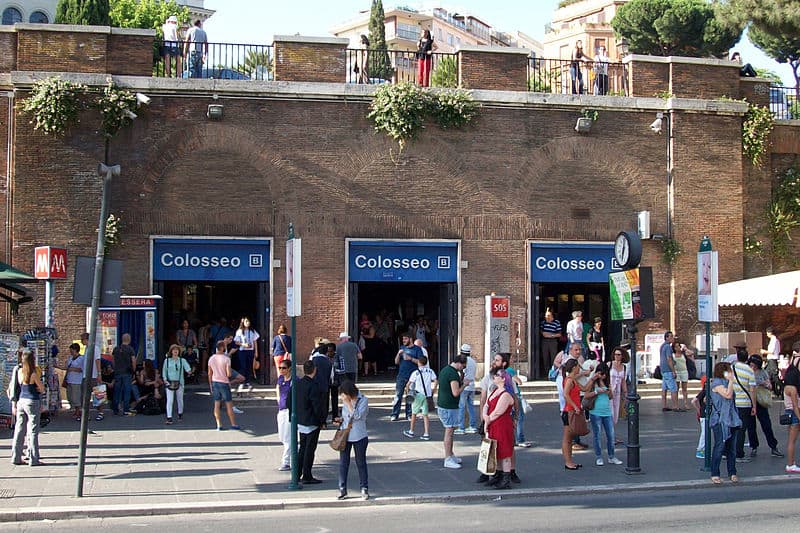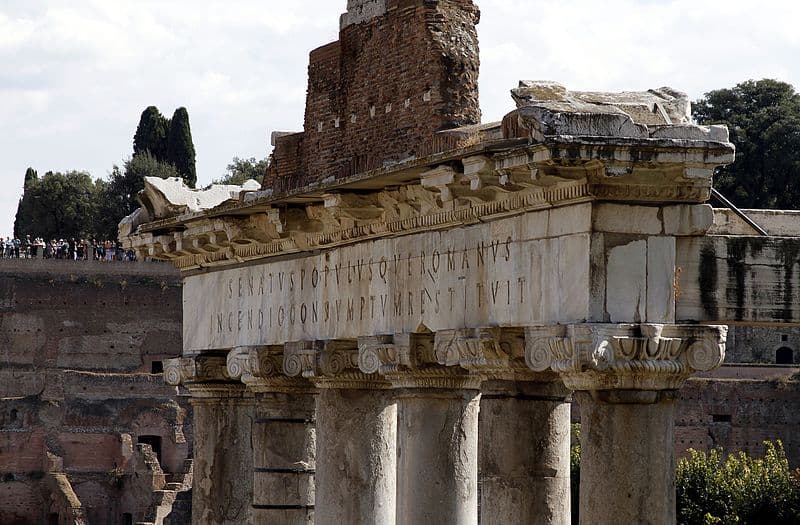Plan your Visit to the Roman Forum
The Colosseum might get all the fame, but the Roman Forum is, in my opinion, the most iconic historical site in Rome. That’s because the Forum was the center of the day-to-day life in the Roman Empire, hosting from Triumphal military parades and religious events to commercial affairs and criminal trials. Nothing happened in Ancient Rome without going through it.
Despite being neglected after the fall of the empire and being used as a quarry during the Middle Ages, the site still doesn’t fail to drop the jaws of the over 4.5 million visitors who wander around its ruins every year. You may be able to take a peek at it from the outside; however, you definitely don’t want to miss the opportunity to visit the Roman Forum.
Buying your ticket
When it comes to entering the Roman Forum area, there is no right way to do it. You may enter with a regular or special ticket, tourist passes, and tourists groups.
Regular ticket at the ticket office
The regular ticket is actually a combined ticket which gives access to the Colosseum, Roman and Imperial Forums, and Palatine Hill. The ticket is valid for 24 hours from first use and you may enter each site once.
REGULAR TICKETS COST €16, OR €2 IF YOU ARE A EUROPEAN UNION MEMBER OF BETWEEN 18 AND 25 YEARS OLD.
IF YOU ARE HANDICAPPED OR UNDER 18 YEARS OLD, ENTRANCE IS FOR FREE.
THE THREE HISTORICAL SITES OPEN AT 8:30 AND CLOSE ONE HOUR BEFORE SUNSET (VARYING DURING THE YEAR).
You can purchase your regular tickets at the Colosseum’s entrance, at Piazza del Colosseo; at the Palatine Hill’s entrance, at Via di San Gregorio, 30; or at the Roman Forum’s entrance, at Via della Salaria Vecchia, adjacent to Via dei Fori Imperialli. The lines at the Palatine Hill’s and Roman Forum’s ticket offices are way shorter than that of the Colosseum’s.
Integrative, Full Experience, and Forum Pass SUPER tickets
Once at the ticket office, you may also upgrade your ticket by purchasing the SUPER Integrative Ticket, which gives you additional access to SUPER sites for €4 extra euros.
The Full Experience Ticket, valid since January 1st 2020 for €22, includes scheduled entrance to the Colosseum with access to the Arena or Underground, and access to the Roman Forum and Palatine Hill, including SUPER sites and temporary exhibitions.
For €16, you may also purchase the Forum Pass SUPER Ticket, which allows access to the Roman Forum, Imperial Forums and Palatine Hill, including SUPER sites.
THE SUPER SITES INCLUDED IN SPECIAL TICKETS ARE LOCATED AT THE PALATINE HILL. THEY ARE: MUSEO PALATINO, CASA DI AUGUSTO, CASA DI LIVIA, AULA ISIACA CON LOGGIA MATTEI, CRIPTOPORTICO NERONIANO, SANTA MARIA ANTIQUA, AND DOMUS TRANSITORIA.
Tourist Passes and tours
If you don’t want to waste any time in line, there are other options on the table. You can either buy your ticket or book a private tour online. You may also purchase especial tourist passes that allow direct entry and include other attractions in the city. The Roma Pass is one of them.
The 48-hour Roma Pass grants you unlimited and free access to Rome’s public transport for the 48 valid hours, free entry into the first museum or archeological site included in the program, and reduced rates to the sites visited afterwards. The pass costs €28. For €38.50, you may opt for the 72-hour Roma Pass, which not only has extended duration, but also allows free entry to the two first sites visited instead of one.
Another option is the Rome City Pass, offered by a company named Turbopass. Roma City Pass is valid from one to seven days, depending on your choice, and includes free and skip-the-line entries to the Roman Forum and other attractions in the catalog. It also includes free one-day Hop-on-Hop-Off bus ticket, free and unlimited access to Rome’s public transport, and free airport transfer. The price goes from €71.90 for one day up to €126.90 for seven days.
How to get to the Roman Forum
Getting to the Roman Forum is quite easy. The entrance is right by Via dei Foro Imperiali, a famous boulevard connecting Piazza Venezia to the Colosseum. By foot, it takes visitors between 10 to 15 minutes to reach the entrance from Piazza Venezia.
If you are riding the metro, take the Metro B line and get off at the Colosseo station. The entrance will be few meters away from the station, across the street on your right side. It takes only 10 minutes to go from Roma Termini to the Colosseo station.
You may also take the 75 bus from Roma Termini. The stop is right in front of the Colosseum, just few meters away from the Roman Forum’s entrance. The bus leaves the station every 15 minutes and takes around 10 minutes to get to the stop near the Forum. Time could increase depending on traffic flow.
Single-use tickets to the metro and the bus COST €1.50.
What to see during your visit
Due to its important political, religious and economic role, the Roman Forum was the heart of Rome’s administration. Because of that, it is home to some of the most important ruins from antiquity.
Differently from other fora, the Roman Forum grew organically with the city, which resulted in the presence of monuments from very different periods of time. Some of the oldest are the Temple of Saturn and the Temple of Castor and Pollux, both constructed circa the end of the 5th century BC.
Temple of Saturn
Although historians disagree on the exact origins of the Temple of Saturn, the temple was most likely inaugurated during the first years of the Republic. It is considered by many specialists the most important and oldest monument dating back to the Roman Republic era after the Temple of Jupiter Optimus Maximus. The latter doesn’t exist anymore.
The Temple of Saturn was dedicated to the god Saturn and served as the starting point of the Saturnalia festival, an important carnival-like celebration in the god’s honor, during which Romans exchanged gifts, had public banquets and promoted parties.
The temple was reconstructed at least three times throughout history and part of the structure is currently missing. However, very special parts still remain, such as the pediment where it reads: “Senatus Populusque Romanus / incendio consumptum restituit” (“The Senate and People of Rome / restored [the temple] consumed by fire”).
Temple of Castor and Pollux

The three columns left from the Temple of Castor and Pollux. Photo by Oliver Mallich on Flickr – www.flickr.com/photos/mtl_shag/344700422
From the Temple of Castor and Pollux, dedicated to the Dioscuri (twin sons of Zeus and Leda), only three pillars, part of the podium and the entablature remain. The 5th-century structure, which had been destroyed, was rebuilt in the 1st century BC in the reign of Tiberius.
The temple was initially built to celebrate the legendary victory at the Battle of Lake Regillus, which would have been possible thanks to the help of Castor and Pollux, who fought alongside the Romans, according to legend. Throughout history, the temple also served as a meeting place for the Roman Senate and as a speech platform. The three columns still standing are known as “The three sisters”.
Tabularium

Portico of Divi Consenti and Tabularium. Photo by Michael Gaylard on Flickr – www.flickr.com/photos/mgaylard/27045260050
The Tabularium is another remarkable building that can be seen from the Forum. It can only be accessed from the Capitoline Museum, but visitors can have a very impressive panoramic view during their visit to the ancient site.
It was built in 78 BC, bellow the Temple of Jupiter Optimus Maximus, as part of a massive redevelopment process subsequent to a fire that destroyed most of the Capitoline Hill in 83 BC. Little is known about its actual functionality or even its true name, but modern scholars suggest it was used as a record office.
Arches of Titus and Septimus Severus
Other famous monuments in the Roman Forum are the Arch of Titus and Arch of Septimus Severus. During Ancient Rome, arches were built to commemorate important military victories. The Arch of Titus was built in circa 81 AD by Titus’s younger brother, Emperor Domitian, to celebrate Titus’s victory over the Jewish rebellion in Judea and his deification shortly after his death.
The arch seems well conserved, but pictures painted in the 18th century reveal it was partially destroyed before undergoing restorations, as we can see in Gaspar van Wittel’s “Rome: View of the Arch of Titus”, painted in the 1710s.
The arch’s inscription reads: “Senatus Populusque Romanus divo Tito divi Vespasiani filio Vespasiano Augusto” (The Senate and the Roman people (dedicate this) to the deified Titus Vespasian Augustus, son of the deified Vespasian”).
The Arch of Septimius Severus was built after that, in 203 AD, by Emperor Septimius Severus to commemorate his victory against the Parthian Empire, from Ancient Iran. At that time, Severus was ruling alongside his two sons, Caracalla and Geta. After his father’s death, Caracalla assassinated his brother and erased all references to Geta from the arch.
Temple of Vesta and House of the Vestal Virgins
The Temple of Vesta and the House of the Vestal Virgins are also very popular. Vestal virgins (or vestals) were priestesses of the goddess of the hearth and home Vesta. These women took a 30-year vow of chastity and took care of Vesta’s sacred fire, which granted them enormous prestige during Ancient Rome.
The Temple of Vesta can be recognized by the remains of its circular structure. It is not clear when the temple was constructed and under whose orders, but records of several reconstructions suggest it might have been first erected before or during the 4th century BC. The current remains were put together in the 1930s during the dictatorship of Benito Mussolini, for the temple had been completely destroyed by the Catholic Church in 1549 in order to have its marble reused in Christian constructions.
The House of the Vestal Virgins, as the name suggests, was where the vestal virgins lived. After the introduction of compulsory Christianity in Rome in the 4th century AD, the building continued to be used as residence to government and papal officials. It was completely abandoned between the 11th and 12th century. Many of the statues that once decorated it are exposed at the House’s yard.
The Curia
The Curia is one of the best preserved monuments in the Roman Forum. In Ancient Rome, several curiae existed, where important political and religious matters where discussed. The one at the Roman Forum, whose construction was initiated by Julius Caesar and finished by Augustus in 29 BC, was named Curia Julia and served as the House of the Roman Senate.
The building was restored several times due to a series of fires in Rome. In 283 AD, an aggressive fire completely destroyed the structure, which was rebuilt by Diocletian right after the incident.
In the 7th century, the Curia was converted into the Church of Sant’Adriano. Byzantine paintings from that era can still be seen. However, just like the Temple of Vesta, the Curia was restored to its 4th century structure in the 1930s by Mussolini under his plan of bringing to his regime the grandeur of Ancient Rome.
The Temple of Antoninus and Faustina

Temple of Antoninus and Faustina. Photo by Kenneth Lu on Flickr – www.flickr.com/photos/toasty/1411124707
The Temple of Divus Antoninus Pius and Diva Faustina is a temple built in 141 AD by Emperor Antoninus Pius to celebrate his deceased and deified wife, Annia Galeria Faustina, known as Faustina I or Faustina the Elder. During the Middle Ages, the construction was partially modified to become the Church of San Lorenzo in Miranda. In 1536, the side chapels and some other modifications were demolished in order to restore the temple for the visit of Roman Emperor Charles V.
Via Sacra
Last but not least: Via Sacra (Sacred Way in English). The street exists since at least the 5th century BC and was of extreme importance during and after the Roman Empire. In Ancient Rome, it was part of the traditional route of the civil and religious ceremony of Roman Triumph, and was the main street in Rome.
While the western stretch of the street constitutes the original ancient direction of Via Sacra, the eastern stretch was built after the 64 AD Great Fire of Rome. As you walk across the Forum through the Sacred Way, centuries of history are on display on both sides, and it is possible to imagine what the Forum looked like in the times of the Empire’s glory.
But don’t be mistaken to think that just because Via Sacra winds up this article there is not more to be seen at the Roman Forum. The site is full of beautiful surprises and is worth the time of a well-planned, thorough visit.
Planning a trip to Paris ? Get ready !
These are Amazon’s best-selling travel products that you may need for coming to Paris.
Bookstore
- The best travel book : Rick Steves – Paris 2023 – Learn more here
- Fodor’s Paris 2024 – Learn more here
Travel Gear
- Venture Pal Lightweight Backpack – Learn more here
- Samsonite Winfield 2 28″ Luggage – Learn more here
- Swig Savvy’s Stainless Steel Insulated Water Bottle – Learn more here
Check Amazon’s best-seller list for the most popular travel accessories. We sometimes read this list just to find out what new travel products people are buying.





















